Microsoft BUILD: Windows 8, A Pre-Beta Preview
by Brian Klug & Ryan Smith on September 13, 2011 12:05 PM EST- Posted in
- BUILD
- Windows
- Microsoft
- Windows 8
- Trade Shows
Mobile Experience Side
Coming from the smartphone side of things, I really see many shades of WP7 inside Windows 8. That’s actually dramatically understating the state of things - the core of what we’ve been shown of Windows 8 that’s new literally is either adopted from or directly analogous to much of WP7.
It doesn’t come as a surprise to me at all that the desktop Windows experience is moving in this direction, (and it seems as though the Xbox 360 interface will follow shortly). The positive result is that Windows 8’s touch experience feels much closer to the ground-up approach Android Honeycomb or iOS have taken than the than the “Tablet-Edition” versions of Windows XP and the tablet integration in Vista and 7. I used a UMPC and remember Origami and how that application lived as its own standalone mode of operation as an application within windows. What Windows 8 is the inverse - Windows now lives inside a Metro-themed Start screen that looks like WP7 for the desktop. Or at least it does in this demo we’ve been shown currently.
The tablet experience is now absolutely on par with modern mobile OSes - sure there are a few more things that need to be included, but the foundation is there for Windows to suddenly become more than an OS that also can do touch-based interaction.
IE 10
Microsoft has been actively promoting IE 10 since MIX 11, with two platform previews so far, and IE 10 is an integral part of Windows 8 both as a browser and as a runtime for HTML based Metro applications. We won’t go into exacting detail about what’s new and interesting inside IE10, beyond mentioning that it improves upon IE 9’s GPU acceleration and improves web compliance support including CSS3. What’s relevant in Windows 8 is that IE 10 gets two views - one belonging to the Metro-heavy start menu experience, which we’ll call the mobile view, and the other belonging to the traditional desktop windows view.
This dichotomy exists between the two IE10 experiences, which is in itself a bit curious. The mobile view is almost exactly what IE looks like inside Windows Phone 7.5 - at the bottom is the URL bar and controls, and with a slide down gesture, at the top are tabs. Meanwhile the IE10 desktop experience uses the older IE 9 UI. At this point, it doesn’t appear that windows opened in one are transportable to the other.
The mobile view is almost exactly like WP7.5’s however, the URL bar disappears when scrolling, and the browser supports a completely fluid multitouch experience that feels speedy.
Cloud
Windows 8 offers considerable integration with Windows Live and SkyDrive. Local user accounts can be directly tied to a Live account on trusted PCs, and then be used for live roaming. Live roaming enables each connected device to access the same set of accounts for photos, email, calendar, and contacts and speed up initial setup. For example, photos captured on a WP7.5 device’s camera roll can be immediately visible on a Windows 8 PC authenticated against the same Live account. This is very close to how camera roll will integrate into Apple’s iCloud and synchronize across iOS and OS X Lion.
One thing is clear, and it’s that Microsoft plans to heavily integrate and leverage its Live services into Windows 8 and provide an ecosystem-wide way to migrate accounts settings, photos, and data between mobile, tablet, and desktop.
Samsung’s Reference Tablet
We’ve been loaned Samsung tablets running the Windows 8 Evaluation copy used for this article, and thought it bears going over since the device will no doubt become a reference platform for Windows 8 development. This hardware is also being given away to developers in attendance at BUILD as well.
The Samsung tablet is none other than the 700T model announced at IFA very recently, and it packs a relatively impressive spec list.
| Samsung 700T Windows 8 Development Notebook/Slate - Specifications | |
| Processor |
Intel Core i5-2467M (2x1.6GHz + HT, 32nm, 3MB L3, 2.3GHz Turbo, 17W) |
| Chipset | Intel 6 series |
| Memory | 4 GB DDR3 1333MHz RAM (1 SODIMM) |
| Graphics | Intel HD 3000 |
| Display | 11.6" Super PLS (1366x768) |
| Hard Drive | 64 GB Samsung SSD |
| Networking | 802.11n WiFi + Gigabit Ethernet + GSM/WCDMA HSPA+ |
| Sensors | NFC, Magenetometer, Accelerometer, GPS, ALS, Front, Rear Camera |
| Dimensions | 12.9 mm thick, 909 grams |
The 700T includes GSM/WCDMA cellular connectivity courtesy of an Option GTM661W combination cellular modem and WiFi card. The GTM661W uses a Qualcomm MDM6200 baseband, which also provides GPS. There are also sensors such as ambient light, an accelerometer, and the two cameras onboard.
In addition, the 700T includes an active digitizer and capacitive touch display, making it suited for all three interaction modes that Windows 8 will support. The device comes with a dock that doubles as a charging stand, and also replicates full size HDMI, GigE, and a USB 2.0 port on the back. The slate has one USB 2.0 port, a headphone jack, microSD card slot, SIM slot, and a rotation lock button.
Samsung calls the 700T a slate, we've elected to call it a tablet, and the device feels decent if not a bit heavy in the hands. The 700T is also the first 16:9 tablet we've seen, with Android adopting 16:10 and iOS going with 4:3, which makes portrait a bit extreme.


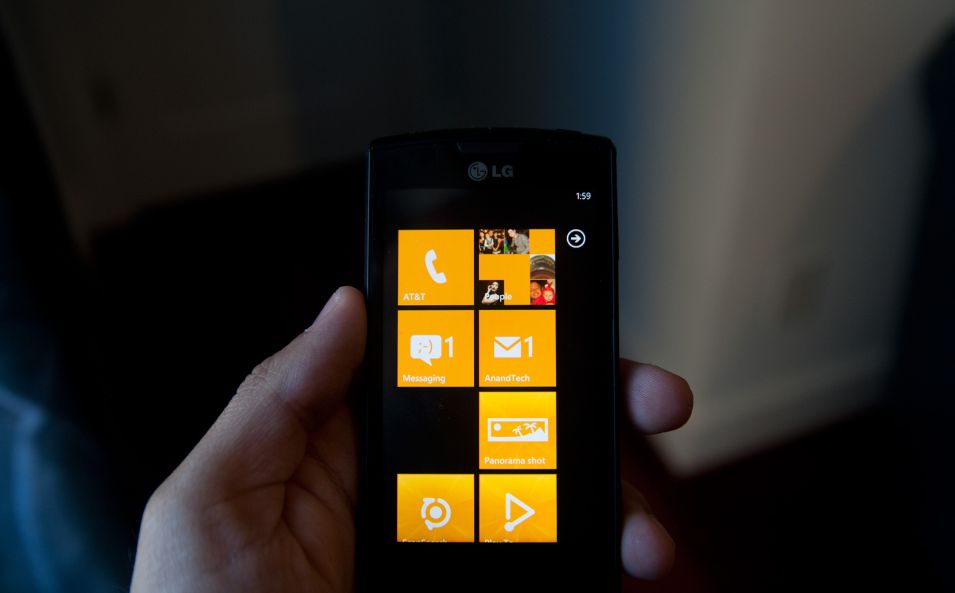
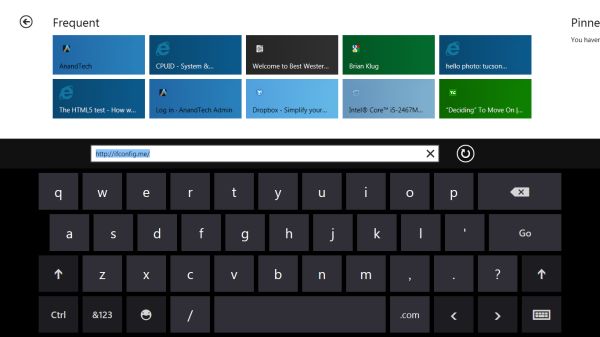
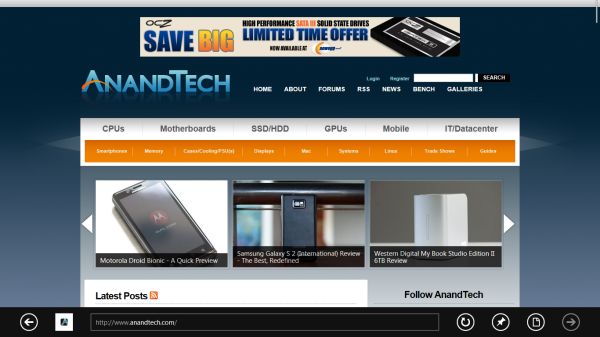
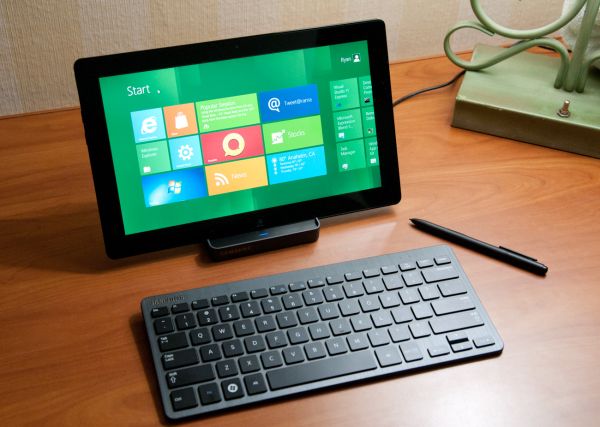
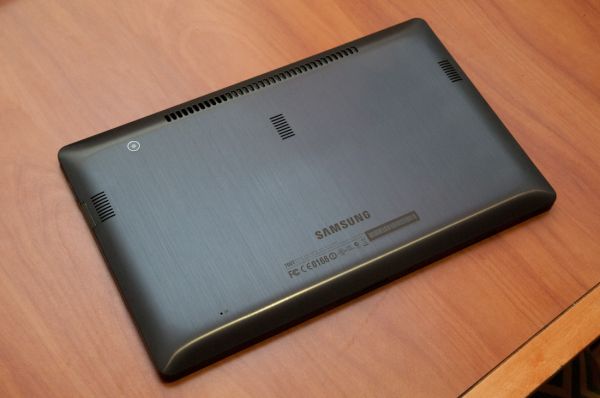
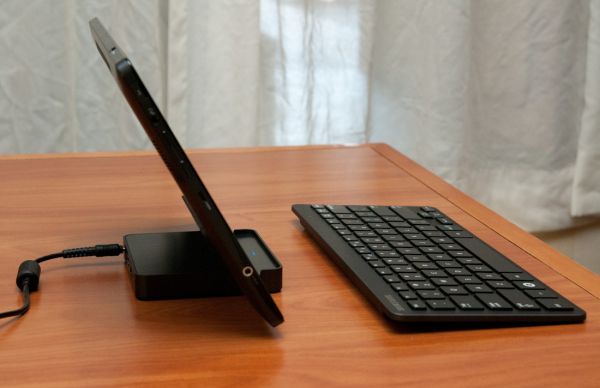








235 Comments
View All Comments
cldudley - Thursday, September 15, 2011 - link
I see these arguments all the time about the application that use the ribbon-based UI, but I don't really see the problem... The most common features are located obviously and are easy to find, what are you using that is inconvenient? Mail-merge maybe, or something less obvious?I put together plenty of spreadsheets and documents using Excel/Word 2010, and I have used AutoCAD 2011 pretty extensively too, and I have no problem with the ribbon.
Maybe I am not doing the tasks you are doing, I write software for specialized controllers, produce drawings and layouts for industrial electrical control equipment, plus write documentation, memos, various tables and schedules, etc. At home I write letters, do the budget, different types of software development, game, etc, and I do not have any of these complaints.
I think the reality for 99.9999% of people is just the curmudgeon factor. "It's not what I am used to, so I don't like it."
gmknobl - Tuesday, September 13, 2011 - link
It appears MS is going for a real sea change here. What's hidden may not be either evolutionary or revolutionary but the GUI appears revolutionary, and that's not necessarily good.If they keep this to tablets only, they'll have to have a big hardware push at the same time and NO issues. In other words, a system that works as well or better than iOS from the start or they are in trouble in the tablet space. However, I think this is their best bet.
But as it stands now, if this isn't an easily disabled option for business and home non-tablet, non-phone computing it will fail in that area completely. One thing Apple got right with their OSes has been usability. (I think Amiga did too back in the day, and Android has now too.) MS has taken around three tries before it got a truly usable OS each time, including Win 7 which is essentially Vista SP2. They can't afford that this time. I cannot see this succeeding with desktops or laptops in the least. It's just too jarring, now matter how innovative it may be.
And I think the whole solid color flat 2d look is dead anyway but that's personal preference.
avddreamr - Tuesday, September 13, 2011 - link
While this format can and does work adequately in a mobile or rather hand held format the compromises that are made for this sort of functionality are simply unacceptable.I hope that this is obvious, because if that's the UI I have to deal with day to day... I will either not upgrade, switch to penguineware, or go fruity.
I would hope that with the vast collection of talent that works for microsoft have to know that the ui should be tailored for its specific use. Give me a 3d-taskbar, with scalable icons, and I'll be happy with the progress in my desktop.
I tell myself that they can't honestly be this stupid... but then I remember windows millennium.
CrapONez - Tuesday, September 13, 2011 - link
I'm at a loss to see how/why Microsoft would abandon a legion of business customers and introduce a new interface requiring retraining, from a mobile device paradigm that it owns a scant few percentage points of. As Kelly Bundy would say: "It wobbles the mind!"alent1234 - Tuesday, September 13, 2011 - link
do companies really spend a lot of money on OS training?damianrobertjones - Tuesday, September 13, 2011 - link
No they don't.Here is the training for Metro
"Do you see the massive Window for Icon there in purple... click it"
Opens Excel in the standard fashion.
"Do you see the saved excel spreadsheet there, right click and attach to the desktop/ui"
User scrolls tyo his/her Excel files.
User... "Ohh that's shiny"
cldudley - Thursday, September 15, 2011 - link
This. I have never had any computer "training" other than sitting down in front of the machine and using it.I may consult the online help quite a lot at first, but after I get used to how things work it all kind of comes together on it's own.
Certainly no employer has ever given me a training class for applications, in 2011 it is just assumed you know how to operate a Windows-based computer and basic Office applications. I don't think there is anything wrong with this assumption.
jecs - Tuesday, September 13, 2011 - link
Ok, tablets, I can see and understand.But do I have to pay full price for a tablet shell on a desktop or a workstation? And if W8 is mostly an interface would MS consider W8 a service pack for desktop use?
I want to skip W8 shell on my desktop, but I may like or need W8 other upgrades at a "fair" reduced price.
If MS does not understand this I wont pay for W8. Lets hope the best for W9.
damianrobertjones - Tuesday, September 13, 2011 - link
They offered Windows 7 at a reduced pricedgingeri - Tuesday, September 13, 2011 - link
It looks a lot like the old Star Trek LCARS system. Sure, LCARS was imaginary for the most part, but the guys who came up with it back when Star Trek: The Next Generation was in pre-production had the same basic ideas behind their design. I'm thinking Paramount might have an nice IP case against Microsoft for this one.